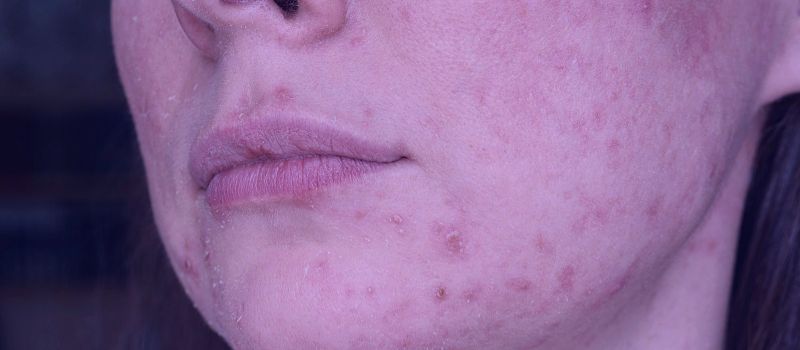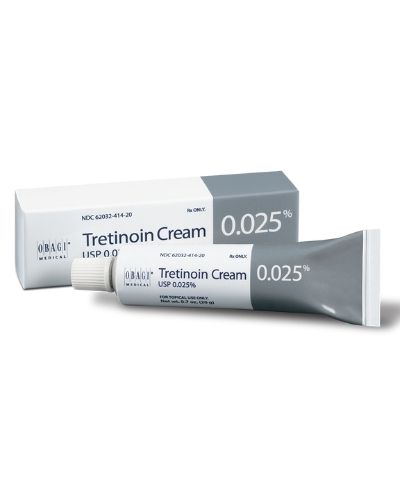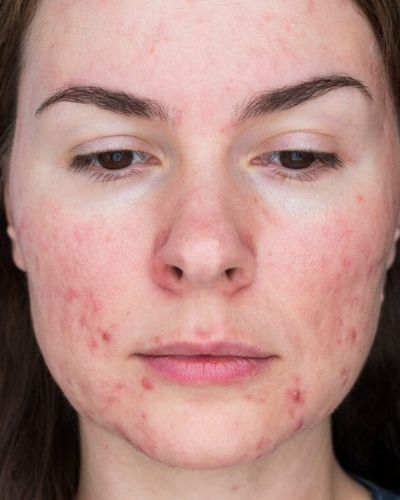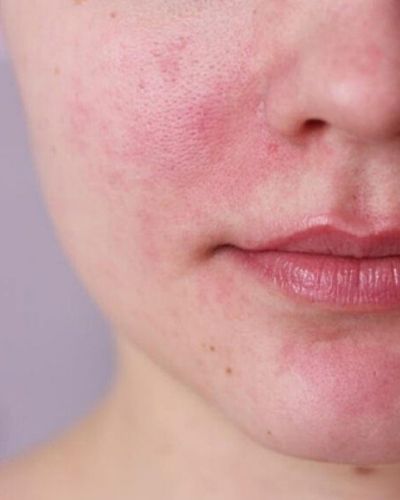Rosacea is a common skin condition that manifests itself as redness, blotchiness, and bumps on the face.
Although there isn’t a treatment that would fully get rid of rosacea, it’s a condition that can be maintained with a good skincare routine and professional treatments.
Since rosacea is one of the most complex and misunderstood conditions, it requires a very careful approach, and people who have this condition should be cautious when selecting the products they would use on their skin.
Therefore, when it comes to targeting signs of aging as well as the pustules that often appear on the skin due to rosacea, some people are concerned whether introducing the anti-aging powerhouse, which is tretinoin, would be a good idea.
And while theoretically, tretinoin cream could work for rosacea, this is definitely something you should be careful with.
In this article, we will discuss tretinoin cream and whether or not you should consider starting it as a treatment for rosacea.
I will also mention some potential side effects you should watch out for, as well as how to safely use tretinoin while dealing with this pesky condition.

What is Rosacea, and What Are the Symptoms?
Rosacea is a common and chronic condition characterized by an inflammatory component composed of papules and pustules and a vascular component composed of flushing and redness.
Rosacea is estimated to affect 16 million Americans, and for some reason, this condition tends to affect women more than it does men.
The main symptoms of rosacea include:
- Redness on the cheeks, nose, chin, or forehead.
- Small bumps that resemble acne.
- Swelling or puffiness around the eyes.
- Dryness and blotchiness.
- Burning, stinging, and severe irritation.
What Causes Rosacea?
Rosacea is a poorly understood dermatological condition, and the root cause is unknown.
However, some contributing factors have been identified, including:
- Demodex mites which are tiny parasites that live burrowed in our pores.
- Helicobacter pylori bacteria, which are germs that live in the digestive tract and stimulate the immune system to produce inflammatory mediators.
- Genetics.
- Environmental and lifestyle factors such as stress, excessive alcohol consumption, and excessive sun exposure.
- Heat and spicy foods.
How Does Tretinoin Work for Treating Rosacea?

Tretinoin is a vitamin A derivative that has been used in dermatology as an acne treatment for over fifty years.
The main tretinoin benefits include diminishing active acne lesions, improving signs of aging such as fine lines and wrinkles, fading hyperpigmentation, and improving sun-damaged skin.
Tretinoin works by speeding up cell turnover (the rate that your skin produces new cells and sheds them from its surface.)
Therefore, after starting tretinoin, your skin cells will travel faster to the surface, purging clogs in the process and revealing a brighter, smoother, healthier, and more unified complexion.
When it comes to treating rosacea, tretinoin has been shown to be a hit and a miss.
A small study published in the Journal of Drugs in Dermatology showed that tretinoin gel combined with clindamycin phosphate was more effective at reducing the number of papules and pustules than metronidazole, a common antibiotic treatment for rosacea.
However, since tretinoin is an incredibly powerful component, it comes with a few side effects, including initial irritation and mild to excessive peeling, which has been a deal-breaker for some people who have rosacea and extremely sensitive skin.
So, while a couple of studies show promising results when it comes to treating rosacea with tretinoin, it really depends on how well your skin adapts to the treatment.
RELATED: Is Tretinoin Good for Cystic Acne?
What Tretinoin Strength is Best for Rosacea?
When dealing with rosacea, your dermatologist will likely start you off with the lowest tretinoin strength, which is 0.025% of either cream or gel, depending on your unique skin needs.
Cream is usually prescribed to people who want to target signs of aging and who have dry skin, while the gel version is given to those with oilier, coarse skin and pustular pimples.
However, the best tretinoin strength for rosacea is usually the micro version, which uses a microsphere formula and is available in 0.04%, 0.08%, and 0.1% strengths.
Currently, tretinoin micro is only carried by the brand Retin-A Micro®, which is available in the US but not in other countries in the world.
Therefore, if you are outside of the US, your derm will likely start you with the mildest tretinoin strength of the usual formulas.
RELATED: Is Stronger Retin-A More Effective?
Side Effects of Using Tretinoin for Rosacea

When starting tretinoin for rosacea, you may experience some side effects such as:
- Dryness and peeling.
- Redness, burning, and stinging.
- Increased sensitivity to the sun.
- Acne flare-ups.
To help minimize these side effects, it is important to start tretinoin gradually and use it consistently.
It’s also important to monitor your skin and not push yourself through the pain if your skin is excessively flaring up and letting you know that it doesn’t accept the treatment.
Rosacea is a difficult condition to maintain, but there are many other products and ingredients that can be helpful. Therefore, if you think tretinoin might not be the one for you, leave it aside, and move on to something else.
How to Use Tretinoin for Rosacea?
The most efficient way to apply tretinoin for rosacea is to sandwich the active between two layers of heavy-duty moisturizer.
Here’s how that works:
- Cleanse with a gentle cleanser.
- Let the skin dry naturally (don’t pat or rub with a towel.)
- Apply a moisturizer while the skin is still damp (not wet.)
- Wait 20-30 minutes.
- Apply a pea-sized amount of tretinoin.
- Wait 20-30 minutes.
- Apply another layer of moisturizer.
Waiting 20-30 minutes is necessary because you don’t want to move the product around while applying moisturizer, as this will give you uneven coverage.
Additionally, there are three most commonly applied methods of tretinoin use, which I talk about in my article How to Layer Tretinoin with Other Products.
Additionally, since tretinoin can cause irritation, sensitivity, and peeling, it is important to take all the necessary precautions to protect your skin, especially when you have rosacea.
Here are some additional tips for using tretinoin for rosacea:
- Use gentle, non-irritating products when starting tretinoin.
- Get rid of products that sting or burn.
- Use a mineral sunscreen of at least SPF 30 every day when using tretinoin, and frequently reapply throughout the day.
- Start slowly and increase frequency gradually as your skin adapts.
- Avoid tretinoin burnout and stop using tretinoin if your skin can’t take it.
Alternative Treatments for Rosacea

If tretinoin doesn’t work for you, other treatments can help reduce the rosacea symptoms.
Here are some of them:
Adapalene
Adapalene is an anti-aging and acne treatment that works similarly to tretinoin but causes less irritation.
This retinoid can help reduce inflammation and treat active acne lesions without causing excessive peeling or dryness, which makes it great for people with rosacea.
Azelaic Acid
Azelaic acid is an incredible ingredient that can diminish the appearance of skin blemishes, help fade post-acne redness, pigmentation, refine the skin’s surface, and reveal a brighter and more even complexion, among other actions.
However, it’s definitely one of the favorite ingredients for people dealing with rosacea because it decreases active inflammation without irritating the skin further.
Sulfur
Sulfur has been seen to actively reduce inflammatory lesions and redness caused by papulopustular rosacea.
But besides that, sulfur may also contribute to a reduction in background redness, and assist in the reduction of facial seborrheic dermatitis in people dealing with “rosacea-seborrheic dermatitis overlap.”
Niacinamide
Niacinamide is a gentle and non-irritating ingredient that helps strengthen the skin barrier and soothe inflammation, making it a great choice for those with rosacea.
It has been shown to improve the appearance of redness, blotchiness, and skin texture while also helping to reduce the appearance of pore size.
Antibiotics
Antibiotics are also often prescribed to treat rosacea, and they are probably the option that works the fastest.
Tetracycline, especially second-generation tetracyclines, including doxycycline and minocycline, have improved bioavailability and are better tolerated.
They have been shown to help reduce redness and inflammation in people with rosacea, making them great options if tretinoin doesn’t work for you.
Additionally, antibiotics such as metronidazole (both oral and topical gel) combined with other topical products such as adapalene have also been shown to help soothe rosacea pustules and redness.
RELATED: Best Products For Cystic Acne

My name is Simone and I am a certified skin specialist. I created this website to teach my readers how to take great care of their skin and I also like to occasionally share my honest opinions on skincare products I’ve tried. You can learn more about me here.
